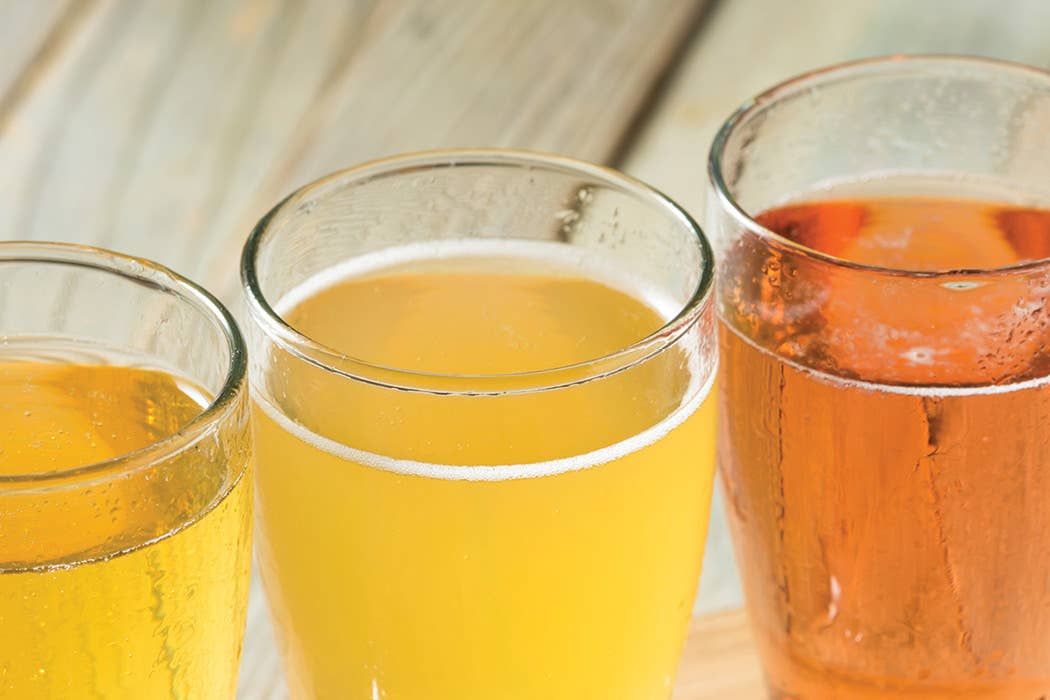Cider tasting
The top three key areas to cider tasting and the best way to drink it

Your guide to Cider tasting
The approach to tasting cider is broadly the same as that with wine, not surprising given that many of the sensorial properties are shared between the two drinks. What is also shared between these two drinks is the importance of fruit. The variety of apple utilised in the cider will entirely determine the product that is achieved.
It is very hard for a single apple variety to achieve all of the properties that are sought after in a cider, therefore the best ciders tend to be a blend of different varieties.
Of course, some people have personal preferences over their cider, and the great thing about cider is that it is a wonderfully diverse and versatile drink. There is a cider suited to every occasion, whether that be quenching a thirst, to savour, to act as an accompaniment to a meal or to celebrate a special event.
There are 3 key areas to cider tasting:
Colour and clarity
Someone far wiser than I once said that ‘the first taste is with the eye’. In terms of colouration, cider ranges from between pale straw to deep, ruby red. This is, of course, entirely dependent upon the apple varieties used. There are no rules or expectations with colour, but I would always treat anything green or black with great suspicion!
Most consumers expect a cider to be crystal clear and this is achieved through filtration. The cider will naturally contain a mild haze, which, if controlled, may befit the product and shouldn’t necessarily be dismissed out of hand. A bottle conditioned product will contain sediment at the bottom. Careful pouring will ensure the sediment is not transferred to the glass.
Aroma
The smell of a cider is critical to presenting a quality product. Even if the cider ends up tasting fabulous, if it has a challenging, or just plain unpleasant aroma, then you’re not going to want to bring the glass to your mouth. A full gamut of aromas could be expected with cider, again dependent upon the apple variety used and what microflora gets involved in the fermentation and maturation. Typical aromas can range from green apple, baked strudel and tropical fruits through to spicy, earthy and even downright funky.
A little bit of funk can go a long way, but it has to be modest and contribute to the overall structure and not dominate. New Zealand sensibilities will dictate that there is a low tolerance to these ‘bretty’ aromas, but they are true to type of English style ciders.
Flavour and mouthfeel
The key to a great cider, much as to life in general, is balance. Cider, without the assistance of the alcohol of wine, or the variety of ingredients of beer, has the potential to be bland or one dimensional. Cider has 4 heroes which, when balanced and working in unison, bring this drink to another level:
Acidity – vivaciousness, freshness, crispness and sometimes sourness
Sweetness – palatability and softness
Phenolics – body, structure and complexity
Fruitiness – richness and mouthfeel
These properties are primarily borne from the apple varieties selected, demonstrating once more that their selection is entirely crucial for determining the end product.
How to serve cider
Cider sits in a unique space between its more heralded alcoholic siblings – it is made like a wine but served (mostly) like a beer. Crucially, cider is equally as versatile as both of these drinks, with a multitude of different formats, styles and occasions to consume this product.
Naturally, like a wine, cider is a still (non-bubbly) drink. However, this form is predominantly reserved for traditional ciders made in England, purchased from the farm gate. The vast majority of consumers understand and expect their ciders to be sparkling, either through a carbonation process, or through bottle conditioning.
It is important to note that the level of carbonation is important. One needs to make sure that when serving cider the carbonation level isn’t too high, as this can mask the palate and upset the flavour balance due to the impact of the carbonic acid.
Draught cider is served in typical beer measures: halves, handles and pints. However, when consuming bottled cider, depending on the style and quality, a tulip glass will be better suited to present the drink and allow the full breath of flavours and aromas to be showcased.
Crucial to cider’s presentation is the serving temperature. There is a great array of highly subtle aromas within cider which can be lost or obfuscated if the drink is overly-chilled. A room temperature cider, however, would be unpalatable to most consumers and would not provide the adequate levels of refreshment expected.
One should treat serving cider at home much like a white wine, such as Pinot Gris or Gewurztraminer: take the cider out of the fridge and put on the table, open and then keep going back to it. For all of cider’s comparable complexity to wine, relatively speaking it lacks alcohol. Sitting at an average of 4.5 – 7.5% abv, this is why cider is normally consumed like a beer. This lower level of alcohol also has cellaring implications.
One of the major reasons why wine has the ability to age well is due to the protection afforded by a high alcohol content. Without such protection afforded, most ciders become oxidised after a short number of years. However rich, robust and highly tannic ciders have the potential for cellaring for up to 5 years, with the benefit of time allowing these drinks to soften and mellow.
Take a look at The Ciderologist for more.